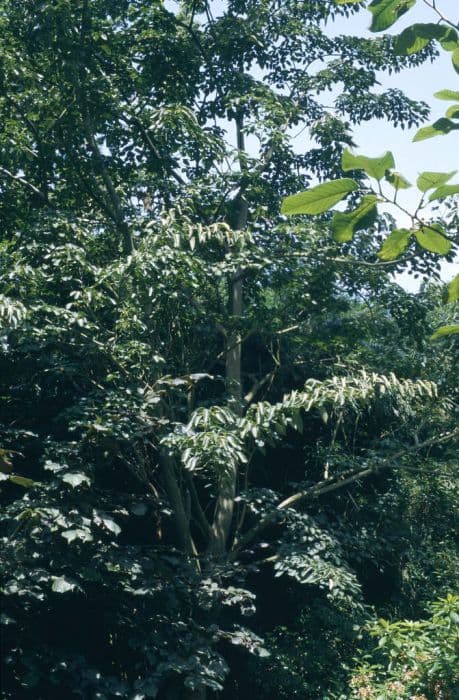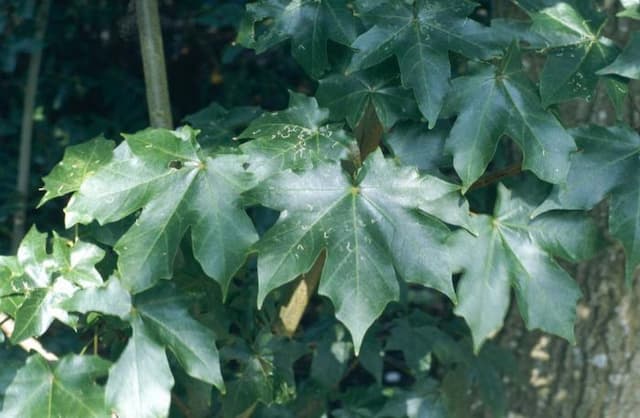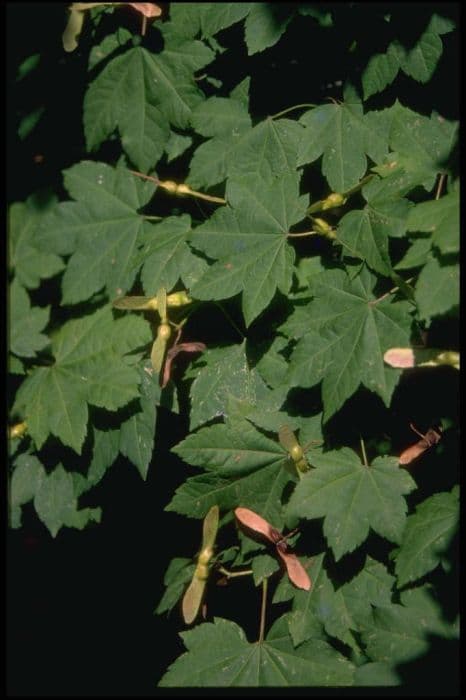Vine Maple Acer grosseri

ABOUT
Acer grosseri, commonly known as the snakebark maple, is a visually striking plant hailing from the maple family. This plant is characterized primarily by its unique and eye-catching bark. The bark displays a prominent snake-like pattern, with vertical stripes that accentuate its distinctive texture. This patterning usually features contrasting colors, often with a light background interlaced with darker lines that create an effect akin to the skin of a serpentine creature. The leaves of the snakebark maple are similarly attractive, with a typical maple shape that is broad and palmately lobed. These leaves usually have a lush green color during the growing season, turning into dazzling shades of yellow, orange, or red as the cooler months arrive, providing a spectacular autumn display. Supporting these leaves are the branches which extend outward, forming a generally spreading canopy that gives the plant an elegant and somewhat layered appearance. The branches themselves are often a reddish or greenish color, complementing the overall aesthetics of the snakebark maple. During the flowering season, the snakebark maple produces modest clusters of flowers that can add to its ornamental value. These are followed by the development of samaras, which are the winged seeds typical of maples. These seeds often appear in pairs and helicopter down from the tree when ripe, aiding in the dispersal of the plant's offspring. In summary, the snakebark maple is a visually appealing plant with its remarkable snake-like bark patterns, attractive foliage that changes color dramatically with the seasons, and an elegant branching structure that altogether make it a striking addition to any suitable garden or landscape, albeit without referencing its size in any form of measurement.
About this plant
 Names
NamesFamily
Sapindaceae
Synonyms
Grosser's Maple, Hers's Maple
Common names
Acer grosseri var. hersii, Acer hersii.
 Toxicity
ToxicityTo humans
Acer grosseri, commonly known as Gros's Maple, is not typically known for being toxic to humans. There is limited information on the toxicity of all parts of the Acer grosseri specifically, but in general, maples are not considered poisonous. It's always wise to exercise caution and avoid ingesting plant material that is not known to be safe.
To pets
When it comes to pets, Acer grosseri, or Gros's Maple, is not usually listed among the plants that are toxic to domestic animals like dogs and cats. However, some species of maple, particularly Acer rubrum (red maple), have been known to cause toxicity in horses if ingested in significant quantities. This could lead to symptoms like disorderly walking, difficulty standing, or a high heart rate. While Acer grosseri does not specifically have a reputation for being harmful to pets, it is always best to prevent pets from ingesting plants, as individual animals might have unique sensitivities.
 Characteristics
CharacteristicsLife cycle
Perennials
Foliage type
Deciduous
Color of leaves
Green
Flower color
Varies
Height
20-30 feet (6-9 meters)
Spread
20-30 feet (6-9 meters)
Plant type
Tree
Hardiness zones
5
Native area
China
Benefits
 General Benefits
General Benefits- Aesthetic Appeal: Acer grosseri, commonly known as maple, is valued for its attractive foliage, which provides visual interest and enhances landscape beauty.
- Shade: The maple's canopy offers shade, creating cooler areas in gardens and parks, which can be beneficial during hot summers.
- Habitat for Wildlife: Maples serve as habitat for various species of birds and insects, contributing to biodiversity in the environment.
- Seasonal Interest: Maples are known for their seasonal color changes, especially in the fall when leaves often turn to vivid shades of red, orange, or yellow.
- Erosion Control: The root system of maples can help stabilize soil and prevent erosion, especially on slopes or in areas prone to heavy rain.
- Wood Production: Acer grosseri can be a source of hardwood, which is used in furniture making and other woodworking projects due to its strength and aesthetic qualities.
- Recreational Use: Parks and public spaces with maple trees are often used for recreational activities, such as picnicking, walking, and photography.
- Education: Maples can serve as a tool for educational purposes, teaching about plant physiology, ecology, and the change of seasons.
 Medical Properties
Medical PropertiesThis plant is not used for medical purposes.
 Air-purifying Qualities
Air-purifying QualitiesThis plant is not specifically known for air purifying qualities.
 Other Uses
Other Uses- The wood of the Acer grosseri, known as the Vine Maple, can be crafted into musical instruments such as flutes or woodwinds for its fine grain and resonance.
- Vine Maple branches are suitable for furniture making and woodworking projects due to their strength and flexibility.
- In some cultures, the Vine Maple's leaves are used as decorative motifs in art and textile designs, inspired by their distinct shape and vibrant autumn colors.
- The sap from the Acer grosseri can be tapped and reduced to make a sweet syrup, similar to how maple syrup is produced from some other maple species.
- The Vine Maple's colorful leaves can be pressed and used in scrapbooking or as a natural element in handmade paper crafting.
- Landscapers use the Acer grosseri for bonsai due to its adaptability and the aesthetic appeal of its miniature fall foliage.
- Due to its twisting branches, the Vine Maple is often used in architectural and garden design as a natural sculpture feature.
- The dense canopy of Acer grosseri can be used to provide shade in small gardens or urban spaces, where larger trees might not be suitable.
- The leaves of the Vine Maple, especially in fall, are used for dyeing fabrics with natural colors that range from yellow to red.
- Acer grosseri branches can be used to create natural fencing or barriers in landscaping, blending functionality with aesthetic beauty.
Interesting Facts
 Feng Shui
Feng ShuiThe Vine Maple is not used in Feng Shui practice.
 Zodiac Sign Compitability
Zodiac Sign CompitabilityThe Vine Maple is not used in astrology practice.
 Plant Symbolism
Plant Symbolism- Resilience: Acer grosseri, commonly known as the Vine Maple, demonstrates the ability to thrive in various conditions, symbolizing adaptability and resilience.
- Growth: The Vine Maple's steady growth from a small sapling to a robust tree represents personal growth and development.
- Protection: With its expansive canopy, the Vine Maple provides shade and shelter, symbolizing protection and safety.
- Beauty: The attractive foliage, especially during the fall when the leaves change color, represents natural beauty and the appreciation of aesthetic qualities.
- Longevity: Trees like the Vine Maple often live for many years, symbolizing endurance and longevity.
 Water
WaterThe preferred common name for Acer grosseri is Snakebark Maple. When watering Snakebark Maple, it is essential to keep the soil consistently moist but not waterlogged. During the growing season (spring and summer), water the tree with approximately 1-2 gallons of water per week, depending on the weather conditions. If the weather is particularly hot or dry, you may need to water the tree twice a week. Reduce watering in the fall and further in winter when the tree is dormant, but do not allow the soil to dry out completely.
 Light
LightSnakebark Maple thrives in partial shade to full sun. The best spot would be an area where the tree is protected from the harsh afternoon sun, especially in hotter climates. Morning sun with dappled afternoon shade is ideal for this tree, as it will allow for even growth without the risk of leaf scorch.
 Temperature
TemperatureSnakebark Maple prefers a temperate climate, with ideal growth temperatures ranging between 60°F and 75°F. It is hardy and can withstand minimum winter temperatures down to 0°F, but should not be exposed to prolonged temperatures below this, to prevent damage to the tree. Summer temperatures exceeding 90°F might be stressful for the plant and should be avoided if possible.
 Pruning
PruningPrune Snakebark Maple in late winter or early spring before the sap starts flowing and new growth begins. The main reasons for pruning are to remove any dead or damaged branches, shape the tree, and encourage healthy growth. Pruning should occur annually to maintain the tree's aesthetic and health. The best time for major pruning is when the tree is still dormant.
 Cleaning
CleaningAs needed
 Soil
SoilThe Henry's Maple (Acer grosseri) thrives in well-draining soil that is rich in organic matter. A mix of loam, peat, and pine bark in equal parts is beneficial. Aim for a soil pH between 5.5 and 7.5 for optimal growth.
 Repotting
RepottingHenry's Maple should be repotted every two to three years to ensure continued growth and avoid becoming root-bound. The best time to repot is in the early spring before new growth begins.
 Humidity & Misting
Humidity & MistingHenry's Maple prefers moderate to high ambient humidity levels. Aim for humidity levels between 40% to 70% for the plant's optimal health and comfort.
 Suitable locations
Suitable locationsIndoor
Ensure bright indirect light, ample airflow, and room to grow.
Outdoor
Place in partial shade, protect from strong winds, and mulch.
Hardiness zone
6-9 USDA
 Life cycle
Life cycleThe life of Acer grosseri, commonly known as Grosser's Maple, begins with seed germination, usually occurring in spring when soil temperatures rise. After sprouting, the seedlings develop into juvenile plants, growing roots, stems, and leaves to harness energy through photosynthesis. As the sapling matures, it undergoes a period of vegetative growth, expanding both in height and girth, with leaves displaying seasonal color changes before dropping in autumn. Sexual maturity is reached within several years, and the tree then produces flowers, which are generally small and inconspicuous, followed by the development of characteristic winged fruits called samaras. These samaras facilitate seed dispersal by wind, allowing the cycle to repeat when they land in a suitable growing environment. Throughout its life cycle, which can span several decades, the Acer grosseri may undergo periods of dormancy during colder months to preserve energy and resources.
 Propogation
PropogationPropogation time
Spring-Early Summer
The most popular method of propagation for Acer grosseri, commonly known as the Snakebark Maple, is through seed. Seed collection should occur when the samaras, or maple "wings," turn brown but before they disperse. This typically happens in the fall. Once collected, seeds require stratification to break dormancy, which involves exposing them to cold temperatures for about 90 to 120 days (approximately 3 to 4 months). They are usually placed in moist sand or peat and stored in a refrigerator at 34 to 41 degrees Fahrenheit (1 to 5 degrees Celsius). After stratification, seeds can be sown in well-drained soil and placed in a sunny or partially shaded location, with germination usually taking place in the spring. Care should be taken not to sow the seeds too deeply; a general rule is to sow them at a depth twice the diameter of the seed.









